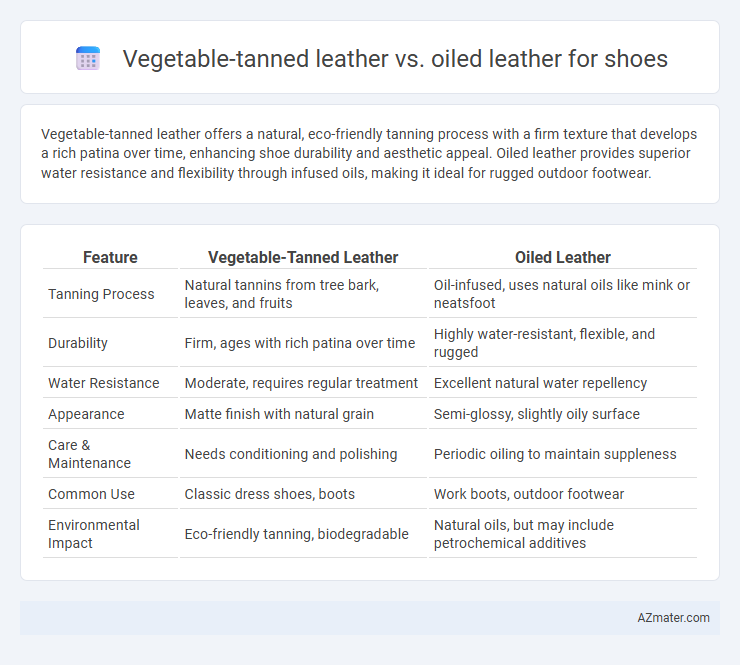Vegetable-tanned leather offers a natural, eco-friendly tanning process with a firm texture that develops a rich patina over time, enhancing shoe durability and aesthetic appeal. Oiled leather provides superior water resistance and flexibility through infused oils, making it ideal for rugged outdoor footwear.
Table of Comparison
| Feature | Vegetable-Tanned Leather | Oiled Leather |
|---|---|---|
| Tanning Process | Natural tannins from tree bark, leaves, and fruits | Oil-infused, uses natural oils like mink or neatsfoot |
| Durability | Firm, ages with rich patina over time | Highly water-resistant, flexible, and rugged |
| Water Resistance | Moderate, requires regular treatment | Excellent natural water repellency |
| Appearance | Matte finish with natural grain | Semi-glossy, slightly oily surface |
| Care & Maintenance | Needs conditioning and polishing | Periodic oiling to maintain suppleness |
| Common Use | Classic dress shoes, boots | Work boots, outdoor footwear |
| Environmental Impact | Eco-friendly tanning, biodegradable | Natural oils, but may include petrochemical additives |
Overview: Vegetable-Tanned vs Oiled Leather
Vegetable-tanned leather is crafted using tannins from natural plant materials, offering a firm, durable texture that develops a rich patina over time, making it ideal for high-quality dress shoes. Oiled leather, treated with oils and waxes, provides enhanced water resistance and a soft, supple feel suited for rugged or casual footwear. Both types prioritize durability and aesthetics, but vegetable-tanned leather excels in breathability and aging gracefully, while oiled leather is preferred for its protective qualities and ease of maintenance.
Leather Production Processes Compared
Vegetable-tanned leather undergoes a natural tanning process using tannins extracted from tree bark, leaves, and fruits, which enhances durability and develops a rich patina over time. Oiled leather is treated with oils and waxes during or after tanning, imparting water resistance and a supple texture while maintaining softness. The vegetable tanning process is slower and more environmentally friendly, whereas oiling adds protective qualities and improves the leather's flexibility and longevity in wet conditions.
Durability and Longevity
Vegetable-tanned leather offers exceptional durability due to its natural tanning process, which enhances strength and resistance to wear over time. Oiled leather features a surface infused with oils and waxes, providing superior water resistance and flexibility but may require more frequent maintenance to preserve longevity. Both types can last many years, yet vegetable-tanned leather typically develops a distinctive patina, improving its aesthetic appeal and durability with age.
Aesthetic Qualities and Aging
Vegetable-tanned leather showcases a rich, natural patina that deepens over time, enhancing shoe aesthetics with a warm, classic look. Oiled leather offers a rugged, matte finish that masks scuffs and maintains a consistent appearance through wear. Both types age uniquely: vegetable-tanned leather develops character and softness, while oiled leather resists water and stains, preserving durability and texture.
Comfort and Wear Experience
Vegetable-tanned leather offers a firm yet breathable structure that molds naturally to the foot, enhancing comfort through personalized fit and moisture regulation. Oiled leather provides superior water resistance and soft suppleness, reducing break-in time and delivering a cushioned, flexible wear experience ideal for varied conditions. Both types develop unique patinas over time, with vegetable-tanned leather aging gracefully and oiled leather maintaining enhanced durability and weather tolerance.
Care and Maintenance Requirements
Vegetable-tanned leather requires regular conditioning with natural oils or creams to prevent drying and cracking, while it benefits from minimal water exposure to maintain its firmness and develop a rich patina over time. Oiled leather demands frequent reapplication of specialized waxes or oils to preserve its water-resistant properties and maintain a supple texture, especially after exposure to moisture or rough conditions. Both types benefit from gentle cleaning with a damp cloth, but oiled leather is more forgiving when it comes to moisture and ideal for rugged outdoor use.
Environmental Impact and Sustainability
Vegetable-tanned leather uses natural tannins from tree bark and plants, resulting in a biodegradable product with a lower chemical footprint compared to chrome-tanned alternatives. Oiled leather, treated with oils and waxes, often requires more frequent maintenance and may contain synthetic additives impacting biodegradability and VOC emissions. Vegetable tanning processes typically consume less water and produce fewer pollutants, making them more sustainable choices for environmentally conscious shoe manufacturing.
Water Resistance and Weather Performance
Vegetable-tanned leather offers moderate water resistance but is more susceptible to damage from prolonged exposure to moisture, making it less ideal for wet conditions without proper treatment. Oiled leather contains natural oils that enhance its water repellency and improve durability against rain and snow, providing superior weather performance. For shoes frequently exposed to wet environments, oiled leather ensures better protection and longer-lasting wear.
Cost Considerations
Vegetable-tanned leather shoes typically have a higher upfront cost due to the time-intensive tanning process and use of natural materials, offering durability and a distinctive aging patina. Oiled leather shoes tend to be more cost-effective initially, benefiting from faster production methods, while providing enhanced water resistance and easier maintenance. While vegetable-tanned leather represents a long-term investment with aging potential, oiled leather offers budget-friendly durability suitable for frequent outdoor wear.
Best Applications for Each Leather Type
Vegetable-tanned leather is best suited for dress shoes and formal footwear due to its firm structure, natural patina development, and breathability that enhances foot comfort during extended wear. Oiled leather excels in casual and outdoor shoes because of its superior water resistance, durability against rough conditions, and ease of maintenance with regular oiling or conditioning. Choosing the right leather type depends on the intended use, with vegetable tanning preferred for elegance and oiled leather favored for rugged performance.

Infographic: Vegetable-tanned leather vs Oiled leather for Shoe
 azmater.com
azmater.com